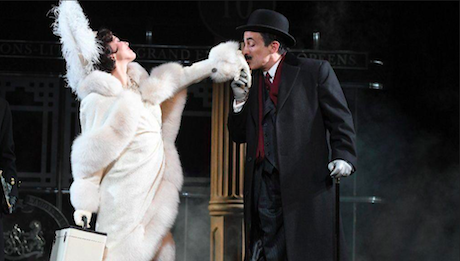'Murder On The Orient Express' A Funny, Fast-Paced Thrill Ride At Hartford Stage
By Christopher Arnott for The Hartford Courant
The fast-moving, powerful theatrical locomotive “Murder on the Orient Express” at Hartford Stage through March 25, makes stops in Syria, Paris and a snowbound, tree-lined landscape in between.
But where it really wants to be is Broadway. Though the characters speak in a host of over-the-top European accents, the patter is New York snappy. The show’s designers are Broadway regulars — costume designer extraordinaire William Ivey Long (a natural for the gig, having done the recent Broadway revival of “On the Twentieth Century”), scenic designer Beowulf Boritt (“Come From Away,” “Meteor Shower”), lighting designer Ken Billington (who worked with Boritt on “Sunday in the Park With George” and “Act One”), sound designer Darron L. West (a regular at the McCarter Theatre Center where “Orient Express” premiered last year) and even wig designer Paul Huntley. The director, Emily Mann, is best known as the artistic director of the McCarter Theatre, and as the adaptor of “Having Our Say,” which was performed at Hartford Stage and Long Wharf two seasons ago, but her resume also includes the 2012 Broadway revival of another show with transportation in its title, “A Streetcar Named Desire.”
Ken Ludwig, the accomplished comic playwright who was chosen expressly by the Agatha Christie estate to adapt the 1934 mystery novel, has had good fortune in New York with the backstage comedies “Lend Me a Tenor” and “Moon Over Buffalo” and the Gershwin-scored musical “Crazy for You.” Ludwig, who also once did his own adaptation of “Twentieth Century” — the original 1932 play, not the musical — in 2004. He’s very much in his comfort zone here, riding in style.
The worry here might be that such a grand, elaborate, Broadway-scaled show might be too big or brassy for a relatively intimate space such as Hartford Stage — we’ve got the Bushnell, or Union Station, for stuff like this.Happily, this “Orient Express” orients itself to work well with this audience. It’s loud and bold, but not distant.
As with its pre-Broadway run of “Anastasia,” (which had a pretty impressive train chugging through it as well) Hartford Stage has turned its distinctive thrust stage into a conventional proscenium set-up. This is not just to mimic a more traditional (and Broadway-friendly) format, or just to allow for more seats in the auditorium. It’s because just about everything happens on a train. It’s a wide, shallow set, more than two train cars long though you only see a bit more than one car at a time. How they fit the rest of that massive set backstage is a mystery as compelling as the one in the play.Eleven people are on this train, a huge number for a new play these days. One member of the cast becomes a corpse pretty quickly. Another is the famed Belgian detective Hercule Poirot, who is called upon to investigate the murder. All the rest are suspects.
If you’ve reread Christie’s novel recently, you know that the book is pretty flat. There’s a murder, a series of interviews and a long-winded explanation. There’s little action and not even much description of the luxurious train or the grand landscapes you can view from its windows. Ludwig has his work cut out for him, and he makes sure not to simply tell when he can show.
As a prologue, Ludwig dramatizes a crime that sets the whole rest of the play in motion; it’s an indulgence that requires a whole different set, and an actor who never turns up again. Then there’s a scene in a Middle Eastern cafe (where Ludwig can’t resist inserting a falafel joke) prior to anybody boarding the Orient Express. Once aboard, the action shifts across two train cars and the back end of the train, while backdrops change.
There’s an old-fashioned opulence to the show — when, after a big build-up, Leigh Ann Larkin’s Countess Andrenyi enters in a gorgeous white gown, the audience responds with audible “oohs” and “ahs.” Special effects aren’t required in order to get big crowd reactions: grace, style and comic timing are. Likewise, the designers eschew projections and other newfangled effects.
The result is a show that has to earn its laughs, its gasps and its heartfelt “awww”s honestly. The costumes are truly gorgeous. The train is magnificent. The performances, while choosing to be over-the-top, are controlled and captivating.
There are twists and turns aplenty on this intrigue-filled international journey. Ludwig jazzes up Christie’s story, sometimes literally with jazz tunes such as “The Charleston.” He adds a bloody incident that’s not in Christie’s book, which keeps the plot jumping mid-play. Christie purists will miss the red kimono, and may take issue with the way Ludwig has combined two characters (Hildegarde Schmidt and Greta Ohlsson) into one. But any quibbles about minor plot points are overwhelmed by the fact that Ken Ludwig has taken a dour mystery involving a dead child and turned it into a laugh riot.
If you want a darker, more philosophical “Orient Express” trip, you have the option of renting the recent Kenneth Branagh film version. This one respects the mystery and its solution, but adds sight gags and lively, animated dialogue that plays like vaudeville routines. The whole cast is on Ludwig’s wavelength. David Pittu plays Hercule Poirot like Inspector Clouseau if he were smart and surefooted — he is all mustache, accent and arrogance. The train manager Monsieur Bouc (Evan Zes, as prissy and preening as Poirot) has been turned into a Dr. Watson type, the ever-present confidante for when plot points need to be explained.
Ludwig gives a lot of attention to one suspect in particular, Helen Hubbard. Instead of a doting mother, she’s a much-married, highly obnoxious American tourist, front and center in many of the play’s most crowded scenes. Hubbard’s played to the hilt by Julie Halston, the comedian and cabaret star who cut her acting teeth as a member of Charles Busch’s outrageous off-off Broadway troupe in the 1980s. If Pittu’s persnicketiness sets a tone for this show, Halston’s hilarious outbursts set the volume. She gets to interrupt, overrule and otherwise command the stage, whether with intermittent whoops or a lengthy comic monologue.
All the actors grab at easy stereotypes, but hold onto them and keep them consistent. (To be fair, the characters are not always who they appear to be, and casually drawn first impressions fuel a lot of the mystery.) The musical theater star Veanne Cox keeps her head low and his shoulders shrugged as the elderly Princess Dragomiroff, evoking the old-lady quirks of “Saturday Night Live”’s Kate McKinnon. There’s a dashing military officer (Ian Bedford), a sweet young governess (Susannah Hoffman), a shy bespectacled secretary (Juha Sorola) and a nun (Samantha Steinmetz).
These are not necessarily the roles that Agatha Christie created. They are made to fit into a different fictional universe, that of classic American melodrama. There is derring-do and suspense. There is a convoluted plot involving oodles of props, from a pocket watch to a hatbox to a button.
Mostly, there are laughs. Director Emily Mann and Ken Ludwig’s intricate script makes sure this train runs on time, and with excellent comic timing. “Murder on the Orient Express” will get you to a better place, and slay you merrily en route.

